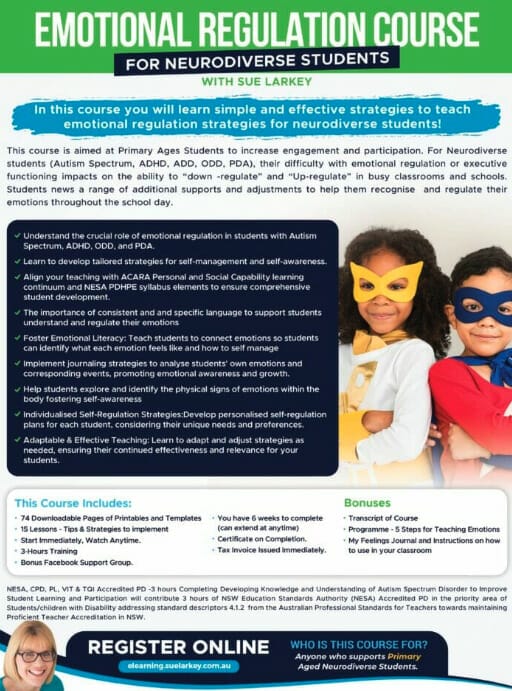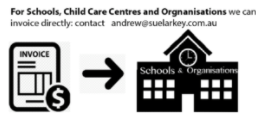How Educators Can Proactively Manage Challenging Behaviour
to Create Calm Classrooms
– Free Webinar & E-Book
Certificate of Attendance is only issued for the Emotional Regulation 3 Hour Course (Not this Free Webinar)
Are you working with children under 6 Years of Age?
Then this webinar might be a better option to understanding behaviour.
In this Creating Calm Classroom Free Training Webinar
You Will Learn:
- The best ways to embrace and support neuro-diverse students so you can make a difference
- Identify tips and strategies to create a calm classroom
- Identify why schools are getting challenging behaviour and what do
- How to best support a range of students with complex behaviour in busy classrooms
DOWNLOAD YOUR EBOOK
In this Guide to Understanding Behaviour E-Book
You Will Learn 50 Different Strategies & Tips:
- 20 Common Reasons for Anger & Anxiety
- 11 Questions to Ask When you See a Behaviour
- Easy Reference to Meltdowns, Shutdowns, Tantrums & Veneer of Coping
- Possible Causes, What is Looks Like & Strategies to Try
- Create a Response Plan
- & more over 20 pages
** New Accredited Online Course**
Emotional Regulation in Students
with an Autism Spectrum and/or other Neurodiversity
– Revised & Updated (3 hours)
In this course you will learn how to teach Emotional Regulation for Neurodiverse Students (Self-Management & Self-Awareness) in your busy & complex classroom:
- Understand the crucial role of emotional regulation in students with Autism Spectrum, ADHD, ODD, PDA, and OCD.
- Learn to develop tailored strategies for self-management and self-awareness.
- Align your teaching with ACARA Personal and Social Capability learning continuum and NESA PDHPE syllabus elements to ensure comprehensive student development.
- The importance of consistent and specific language to support students understand and regulate their emotions
- Foster Emotional Literacy: Teach students to connect emotions so students can identify what each emotion feels like and how to self manage
- Implement journaling strategies to analyse students' own emotions and corresponding events, promoting emotional awareness and growth.
- Help students explore and identify the physical signs of emotions within the body fostering self-awareness
- Individualised Self-Regulation Strategies:Develop personalised self-regulation plans for each student, considering their unique needs and preferences.
- Adaptable & Effective Teaching: Learn to adapt and adjust strategies as needed, ensuring their continued effectiveness and relevance for your students
-
Also includes:
- 74 Downloadable Pages of Printables and Templates.
- Transcript of Course
- Programme - 5 Steps for Teaching Emotions
- My Feelings Journal and Instructions on How to use in your classroom
What you will learn in this 3-hour accredited course:
* How to help children identify and label emotions in themselves and others
* Helping children connect emotions to events
* A range of strategies to regulate emotions and behaviours
* Activities to do with the whole class, small groups & individuals
* What to teach
* How to teach
* When to teach
* & more

Plus 5 Free Bonuses
* 2 Extra Weeks to Access the Course = 8 weeks of access
* 5 Steps for Teaching Emotions
* My Feelings Journal and instructions on how to use in your classroom
Key Details
* 4 Modules
* 15 Lessons
* 23 Page Handout with Clear, Actionable Steps
* 74 Pages of Printables and Templates
* 6 weeks to complete the course
* PD Certificate Issued on Completion of Course
* 3 Hours Accredited PD (TQI, NESA – teacher identified hrs) and can be used in all States for Professional Development
* Ongoing IT support
* 30 Day Money Back Guarantee
* Tax Invoice issued Immediately
Certificate at conclusion of this Course
A$149.00
Register Now & Pay Later
We can start you on the Course and invoice your Organisation directly to pay later.
Email Geoff at support@suelarkey.com.au
Groups - Register Now & Pay Later
Email Geoff - support@suelarkey.com.au the following:
- Person's Full Name (for Certificate)
- Person Direct Email Address (for the login and course details)
- School/Orgnanisation Name
- Person Name and Email to send invoice


